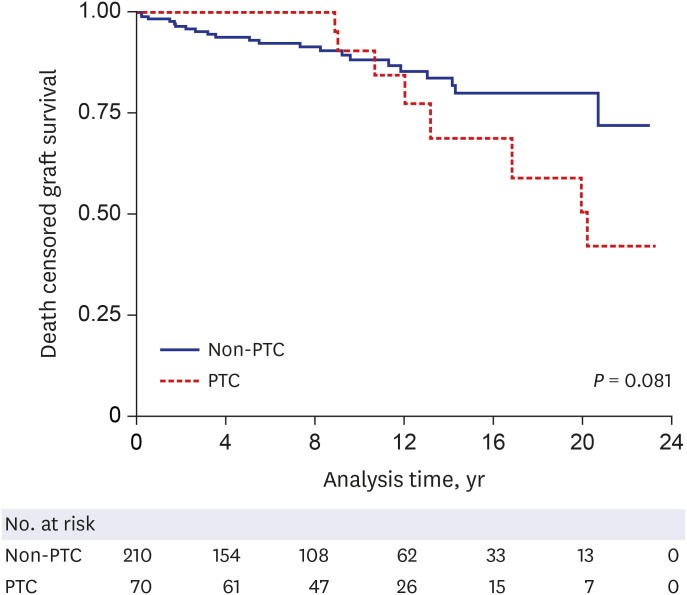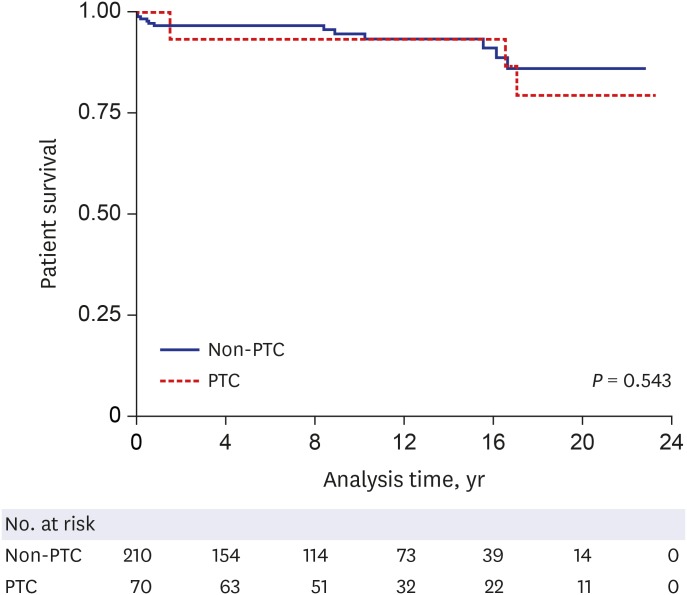J Korean Med Sci.
2020 May;35(20):e166. 10.3346/jkms.2020.35.e166.
Risk of Graft Failure in Kidney Recipients with Cured Post-Transplant Cancer
- Affiliations
-
- 1Department of Internal Medicine, Seoul National University College of Medicine, Seoul, Korea
- 2Department of Surgery, Seoul National University College of Medicine, Seoul, Korea
- KMID: 2500847
- DOI: http://doi.org/10.3346/jkms.2020.35.e166
Abstract
- Background
Post-transplant cancer (PTC) is a critical complication after kidney transplantation. However, whether successfully cured PTC affects the long-term graft outcome remains unclear.
Methods
We retrospectively reviewed 1,629 kidney transplant recipients from 1995 to 2017 after excluding patients with post-transplant hematologic or advanced non-curable cancers and who underwent allograft nephrectomy because of cancer. Cured PTCs were defined as cancers treated with curative methods and/or adjuvant therapy without recurrence during ≥ 2 years. Propensity score matching was performed to match cured PTC patients with cancer-naïve patients (i.e., non-PTC group).
Results
During the median period of 7 years (maximum, 23 years), 70 patients (4.3%) had cured PTCs. The PTC group showed significantly higher risks of death-censored graft failure (adjusted hazard ratio [HR], 2.56 [1.05–6.23]), class II donor-specific antibodies (adjusted HRs, 3.37 [1.30–8.71]), estimated glomerular filtration rate < 30 mL/min/1.73 m2 (adjusted HR, 2.68 [1.43–5.02]) and random urine protein/creatinine ratio > 1 g (adjusted HR, 3.61 [1.92–6.79]) compared to non-PTC group. However, the risk of mortality was not different between the PTC and non-PTC groups. According to the cancer type, only urogenital cancer had a significant association with graft failure (adjusted HR, 4.26 [1.19–15.22]) and the gastrointestinal cancer showed elevated risk of T cell mediated rejection compared to non-PTC (adjusted HR, 20.44 [6.02–69.39]).
Conclusion
Appropriate monitoring of graft function is necessary in patients with cured PTCs.
Keyword
Figure
Reference
-
1. Hart A, Smith JM, Skeans MA, Gustafson SK, Wilk AR, Robinson A, et al. OPTN/SRTR 2016 annual data report: kidney. Am J Transplant. 2018; 18(Suppl 1):18–113. PMID: 29292608.
Article2. Matas AJ, Gillingham KJ, Humar A, Kandaswamy R, Sutherland DE, Payne WD, et al. 2202 kidney transplant recipients with 10 years of graft function: what happens next? Am J Transplant. 2008; 8(11):2410–2419. PMID: 18925907.
Article3. Israni AK, Snyder JJ, Skeans MA, Peng Y, Maclean JR, Weinhandl ED, et al. Predicting coronary heart disease after kidney transplantation: Patient Outcomes in Renal Transplantation (PORT) study. Am J Transplant. 2010; 10(2):338–353. PMID: 20415903.
Article4. Gallagher MP, Kelly PJ, Jardine M, Perkovic V, Cass A, Craig JC, et al. Long-term cancer risk of immunosuppressive regimens after kidney transplantation. J Am Soc Nephrol. 2010; 21(5):852–858. PMID: 20431040.
Article5. Porrini EL, Díaz JM, Moreso F, Delgado Mallén PI, Silva Torres I, Ibernon M, et al. Clinical evolution of post-transplant diabetes mellitus. Nephrol Dial Transplant. 2016; 31(3):495–505. PMID: 26538615.
Article6. Grulich AE, van Leeuwen MT, Falster MO, Vajdic CM. Incidence of cancers in people with HIV/AIDS compared with immunosuppressed transplant recipients: a meta-analysis. Lancet. 2007; 370(9581):59–67. PMID: 17617273.
Article7. van de Wetering J, Roodnat JI, Hemke AC, Hoitsma AJ, Weimar W. Patient survival after the diagnosis of cancer in renal transplant recipients: a nested case-control study. Transplantation. 2010; 90(12):1542–1546. PMID: 21076383.
Article8. Kiberd BA, Rose C, Gill JS. Cancer mortality in kidney transplantation. Am J Transplant. 2009; 9(8):1868–1875. PMID: 19563337.
Article9. Au E, Wong G, Chapman JR. Cancer in kidney transplant recipients. Nat Rev Nephrol. 2018; 14(8):508–520. PMID: 29802400.
Article10. Kasiske BL, Snyder JJ, Gilbertson DT, Wang C. Cancer after kidney transplantation in the United States. Am J Transplant. 2004; 4(6):905–913. PMID: 15147424.
Article11. Vajdic CM, McDonald SP, McCredie MR, van Leeuwen MT, Stewart JH, Law M, et al. Cancer incidence before and after kidney transplantation. JAMA. 2006; 296(23):2823–2831. PMID: 17179459.
Article12. Melosky B, Karim M, Chui A, McBride M, Cameron EC, Yeung CK, et al. Lymphoproliferative disorders after renal transplantation in patients receiving triple or quadruple immunosuppression. J Am Soc Nephrol. 1992; 2(12):Suppl. S290–S294. PMID: 1323341.
Article13. Opelz G, Henderson R. Incidence of non-Hodgkin lymphoma in kidney and heart transplant recipients. Lancet. 1993; 342(8886-8887):1514–1516. PMID: 7902900.
Article14. Hung YM, Chou KJ, Hung SY, Chung HM, Chang JC. De novo malignancies after kidney transplantation. Urology. 2007; 69(6):1041–1044. PMID: 17572182.
Article15. Morath C, Mueller M, Goldschmidt H, Schwenger V, Opelz G, Zeier M. Malignancy in renal transplantation. J Am Soc Nephrol. 2004; 15(6):1582–1588. PMID: 15153569.16. Lim WH, Turner RM, Chapman JR, Ma MK, Webster AC, Craig JC, et al. Acute rejection, T-cell-depleting antibodies, and cancer after transplantation. Transplantation. 2014; 97(8):817–825. PMID: 24521777.
Article17. Amin MB, Edge S, Greene F, Byrd DR, Brookland RK, Washington MK, et al. AJCC Cancer Staging Manual. 8th ed. New York, NY: Springer International Publishing;2017.18. Haas M, Loupy A, Lefaucheur C, Roufosse C, Glotz D, Seron D, et al. The Banff 2017 Kidney Meeting Report: revised diagnostic criteria for chronic active T cell-mediated rejection, antibody-mediated rejection, and prospects for integrative endpoints for next-generation clinical trials. Am J Transplant. 2018; 18(2):293–307. PMID: 29243394.
Article19. Chadban SJ, Barraclough KA, Campbell SB, Clark CJ, Coates PT, Cohney SJ, et al. KHA-CARI guideline: KHA-CARI adaptation of the KDIGO clinical practice guideline for the care of kidney transplant recipients. Nephrology (Carlton). 2012; 17(3):204–214. PMID: 22212251.
Article20. KDIGO clinical practice guideline for the care of kidney transplant recipients. Am J Transplant. 2009; 9(Suppl 3):S1–S155.21. Knoll GA, Blydt-Hansen TD, Campbell P, Cantarovich M, Cole E, Fairhead T, et al. Canadian Society of Transplantation and Canadian Society of Nephrology commentary on the 2009 KDIGO clinical practice guideline for the care of kidney transplant recipients. Am J Kidney Dis. 2010; 56(2):219–246. PMID: 20659623.
Article22. Cena T, Musetti C, Quaglia M, Magnani C, Stratta P, Bagnardi V, et al. De novo noncutaneous malignancies after kidney transplantation are associated with an increased risk of graft failure: results from a time-dependent analysis on 672 patients. Transpl Int. 2016; 29(10):1085–1093. PMID: 27343849.23. Rabot N, Büchler M, Foucher Y, Moreau A, Debiais C, Machet MC, et al. CNI withdrawal for post-transplant lymphoproliferative disorders in kidney transplant is an independent risk factor for graft failure and mortality. Transpl Int. 2014; 27(9):956–965. PMID: 24964147.
Article24. Chen DS, Mellman I. Elements of cancer immunity and the cancer-immune set point. Nature. 2017; 541(7637):321–330. PMID: 28102259.
Article25. Hotta K, Sho M, Fujimoto K, Shimada K, Yamato I, Anai S, et al. Prognostic significance of CD45RO+ memory T cells in renal cell carcinoma. Br J Cancer. 2011; 105(8):1191–1196. PMID: 21934683.
Article26. Raman R, Vaena D. Immunotherapy in metastatic renal cell carcinoma: a comprehensive review. Biomed Res Int. 2015; 2015:367354. PMID: 26161397.
Article27. Ma Z, Bao X, Gu J. Effects of laparoscopic radical gastrectomy and the influence on immune function and inflammatory factors. Exp Ther Med. 2016; 12(2):983–986. PMID: 27446308.
Article28. Karanika S, Karantanos T, Theodoropoulos GE. Immune response after laparoscopic colectomy for cancer: a review. Gastroenterol Rep (Oxf). 2013; 1(2):85–94. PMID: 24759813.
Article29. Cheung CY, Man Ma MK, Chak WL, Chau KF, Tang SC. Conversion to mammalian target of rapamycin inhibitors in kidney transplant recipients with de novo cancers. Oncotarget. 2017; 8(27):44833–44841. PMID: 28160552.
Article
- Full Text Links
- Actions
-
Cited
- CITED
-
- Close
- Share
- Similar articles
-
- Lived Experience of Kidney Transplant Recipients with Kidney Graft Failure
- Malignancy in Renal Transplant Recipients
- A Concept Analysis of Compliance in Kidney Transplant Recipient Including Compliance with Immunosuppressive Medication
- Surgical Complications are Major Problems Concerning Overseas Kidney Transplantation in Comparison Study with Domestic Deceased Donor Kidney Transplantation
- Changes in socioeconomic status and patient outcomes in kidney transplantation recipients in South Korea



